engine BMW 5 SERIES 1999 E39 Drive Away Protection Syst
[x] Cancel search | Manufacturer: BMW, Model Year: 1999, Model line: 5 SERIES, Model: BMW 5 SERIES 1999 E39Pages: 30, PDF Size: 0.7 MB
Page 4 of 30
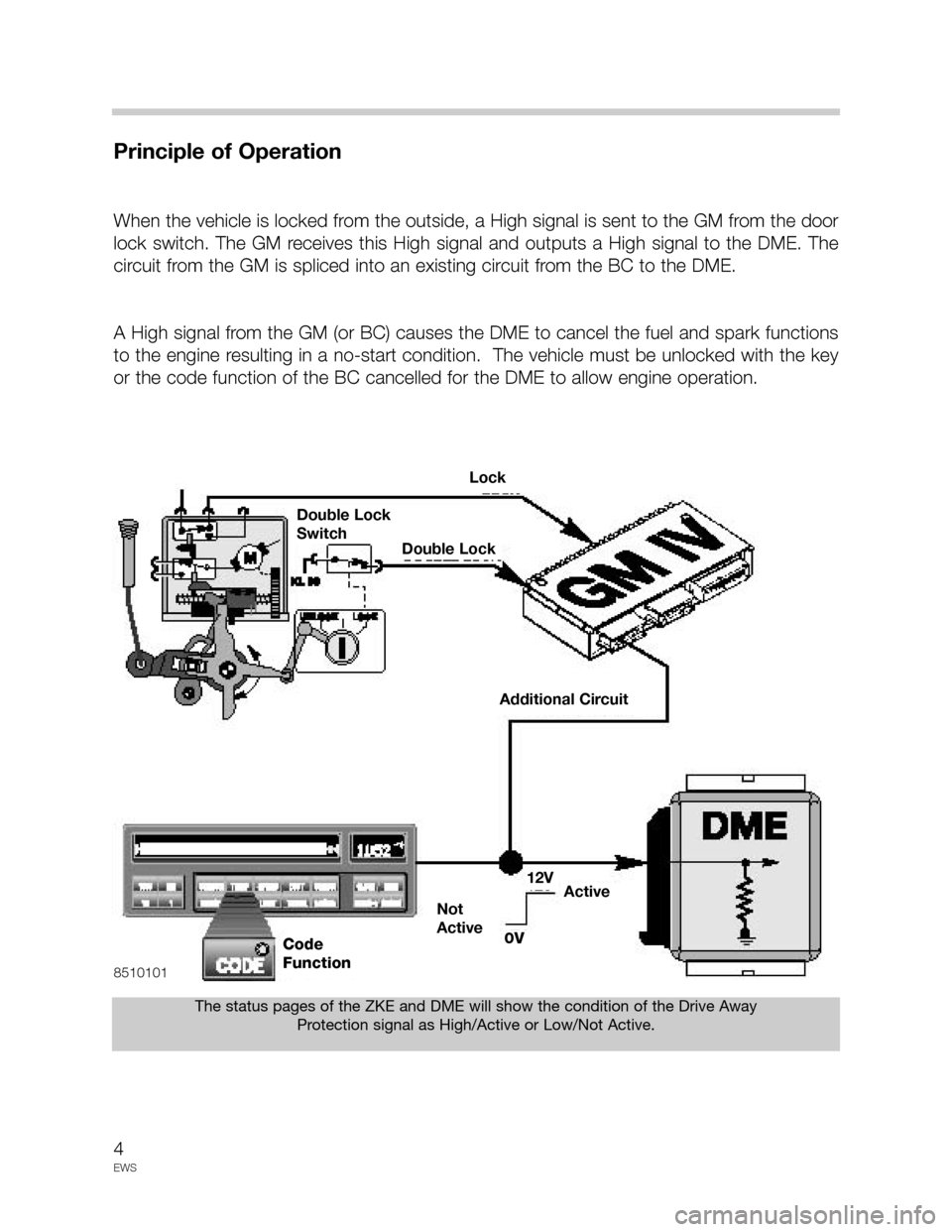
4
EWS
Principle of Operation
When the vehicle is locked from the outside, a High signal is sent to the GM from the door
lock switch. The GM receives this High signal and outputs a High signal to the DME. The
circuit from the GM is spliced into an existing circuit from the BC to the DME.
A High signal from the GM (or BC) causes the DME to cancel the fuel and spark functions
to the engine resulting in a no-start condition. The vehicle must be unlocked with the key
or the code function of the BC cancelled for the DME to allow engine operation.
The status pages of the ZKE and DME will show the condition of the Drive Away
Protection signal as High/Active or Low/Not Active.
8510101
Lock
Double Lock
Double Lock
Switch
Additional Circuit
12VActive
Not
Active
0VCode
Function
Page 5 of 30
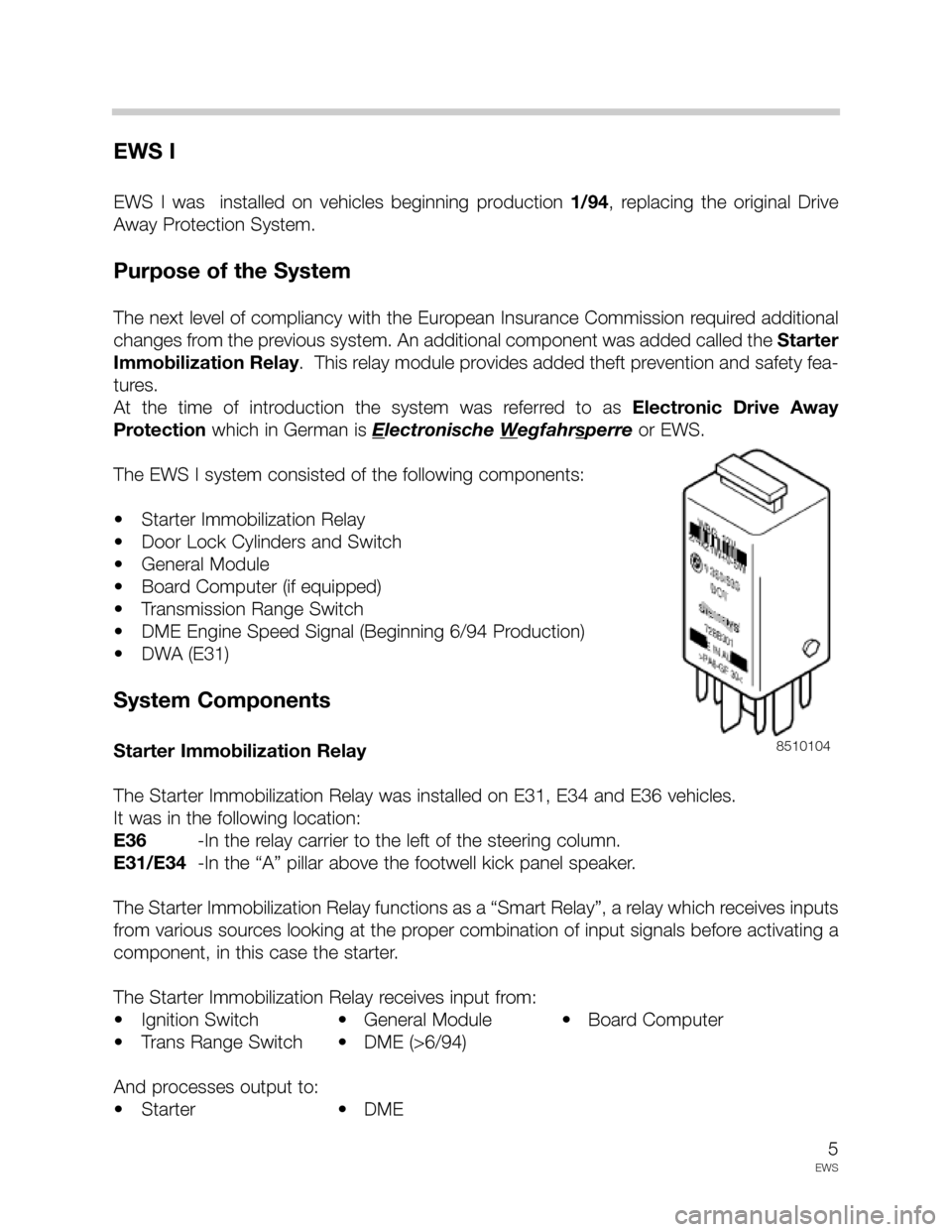
5
EWS
EWS I
EWS I was installed on vehicles beginning production 1/94, replacing the original Drive
Away Protection System.
Purpose of the System
The next level of compliancy with the European Insurance Commission required additional
changes from the previous system. An additional component was added called the Starter
Immobilization Relay. This relay module provides added theft prevention and safety fea-
tures.
At the time of introduction the system was referred to as Electronic Drive Away
Protectionwhich in German is E
lectronische Wegfahrsperreor EWS.
The EWS I system consisted of the following components:
• Starter Immobilization Relay
• Door Lock Cylinders and Switch
• General Module
• Board Computer (if equipped)
• Transmission Range Switch
• DME Engine Speed Signal (Beginning 6/94 Production)
• DWA (E31)
System Components
Starter Immobilization Relay
The Starter Immobilization Relay was installed on E31, E34 and E36 vehicles.
It was in the following location:
E36 -In the relay carrier to the left of the steering column.
E31/E34-In the “A” pillar above the footwell kick panel speaker.
The Starter Immobilization Relay functions as a “Smart Relay”, a relay which receives inputs
from various sources looking at the proper combination of input signals before activating a
component, in this case the starter.
The Starter Immobilization Relay receives input from:
• Ignition Switch • General Module • Board Computer
• Trans Range Switch • DME (>6/94)
And processes output to:
• Starter • DME8510104
Page 6 of 30
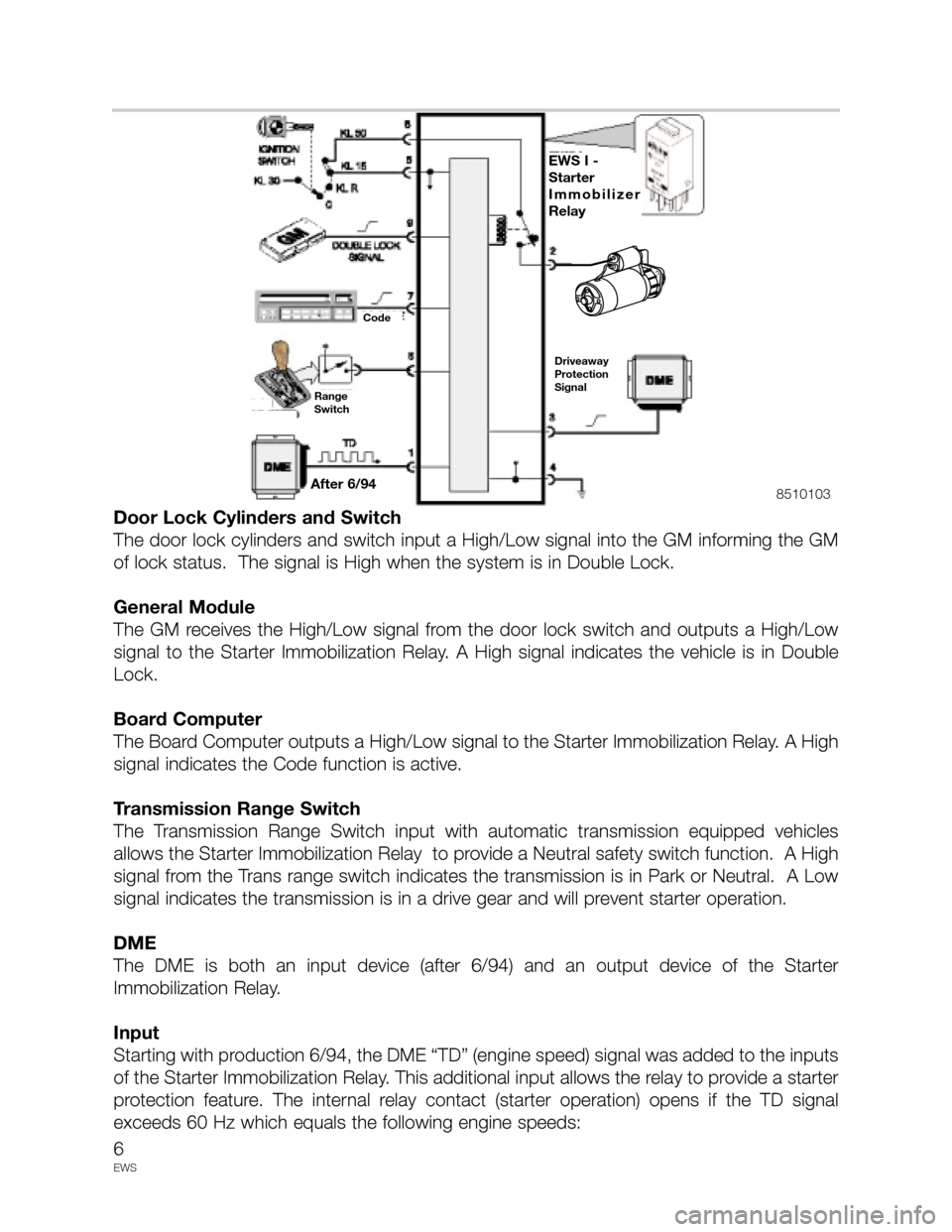
6
EWS
Door Lock Cylinders and Switch
The door lock cylinders and switch input a High/Low signal into the GM informing the GM
of lock status. The signal is High when the system is in Double Lock.
General Module
The GM receives the High/Low signal from the door lock switch and outputs a High/Low
signal to the Starter Immobilization Relay. A High signal indicates the vehicle is in Double
Lock.
Board Computer
The Board Computer outputs a High/Low signal to the Starter Immobilization Relay. A High
signal indicates the Code function is active.
Transmission Range Switch
The Transmission Range Switch input with automatic transmission equipped vehicles
allows the Starter Immobilization Relay to provide a Neutral safety switch function. A High
signal from the Trans range switch indicates the transmission is in Park or Neutral. A Low
signal indicates the transmission is in a drive gear and will prevent starter operation.
DME
The DME is both an input device (after 6/94) and an output device of the Starter
Immobilization Relay.
Input
Starting with production 6/94, the DME “TD” (engine speed) signal was added to the inputs
of the Starter Immobilization Relay. This additional input allows the relay to provide a starter
protection feature. The internal relay contact (starter operation) opens if the TD signal
exceeds 60 Hz which equals the following engine speeds:
8510103
EWS I -
Starter
Immobilizer
Relay
After 6/94
Driveaway
Protection
Signal
Range
Switch
Code
Page 7 of 30
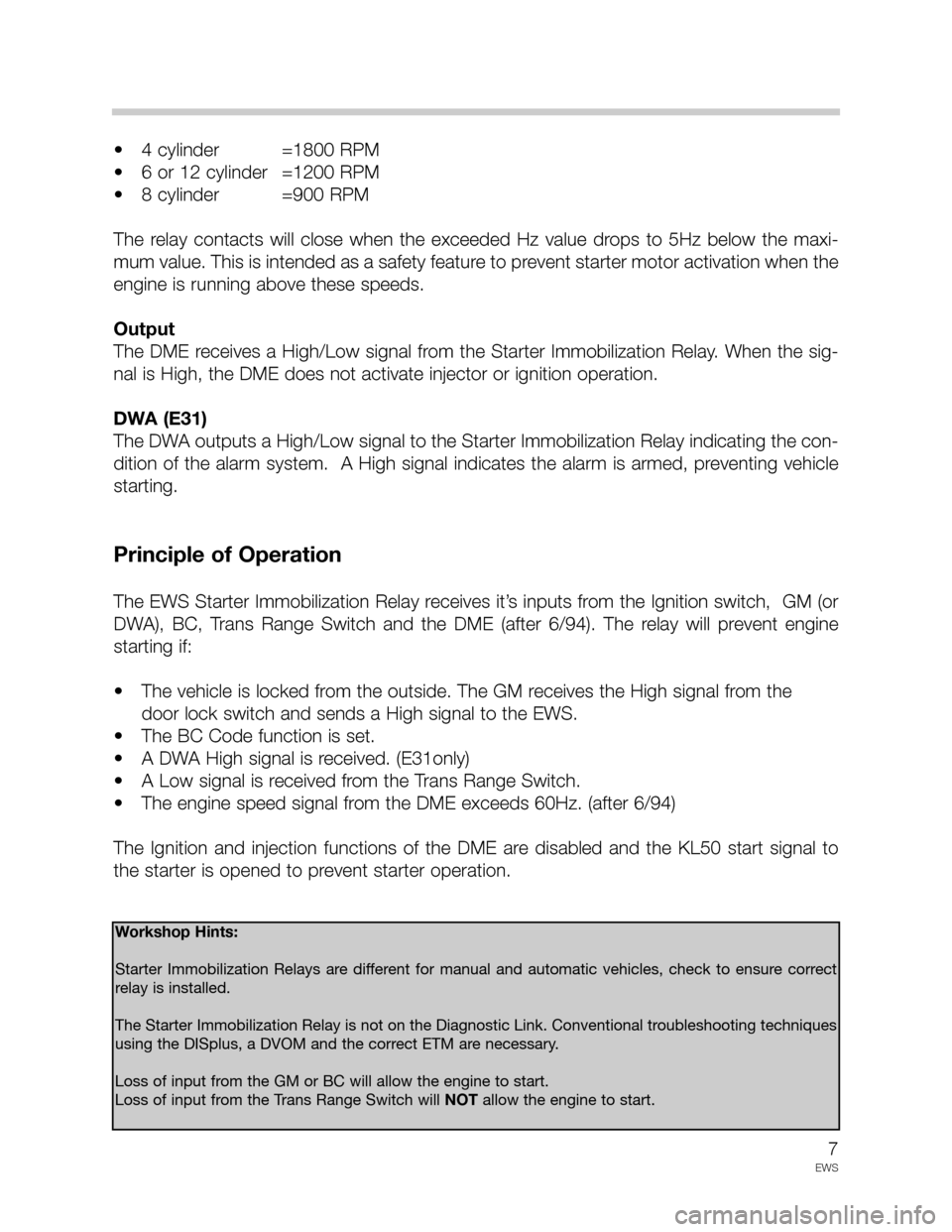
7
EWS
• 4 cylinder =1800 RPM
• 6 or 12 cylinder =1200 RPM
• 8 cylinder =900 RPM
The relay contacts will close when the exceeded Hz value drops to 5Hz below the maxi-
mum value. This is intended as a safety feature to prevent starter motor activation when the
engine is running above these speeds.
Output
The DME receives a High/Low signal from the Starter Immobilization Relay. When the sig-
nal is High, the DME does not activate injector or ignition operation.
DWA (E31)
The DWA outputs a High/Low signal to the Starter Immobilization Relay indicating the con-
dition of the alarm system. A High signal indicates the alarm is armed, preventing vehicle
starting.
Principle of Operation
The EWS Starter Immobilization Relay receives it’s inputs from the Ignition switch, GM (or
DWA), BC, Trans Range Switch and the DME (after 6/94). The relay will prevent engine
starting if:
• The vehicle is locked from the outside. The GM receives the High signal from the
door lock switch and sends a High signal to the EWS.
• The BC Code function is set.
• A DWA High signal is received. (E31only)
• A Low signal is received from the Trans Range Switch.
• The engine speed signal from the DME exceeds 60Hz. (after 6/94)
The Ignition and injection functions of the DME are disabled and the KL50 start signal to
the starter is opened to prevent starter operation.
Workshop Hints:
Starter Immobilization Relays are different for manual and automatic vehicles, check to ensure correct
relay is installed.
The Starter Immobilization Relay is not on the Diagnostic Link. Conventional troubleshooting techniques
using the DISplus, a DVOM and the correct ETM are necessary.
Loss of input from the GM or BC will allow the engine to start.
Loss of input from the Trans Range Switch will NOTallow the engine to start.
Page 8 of 30
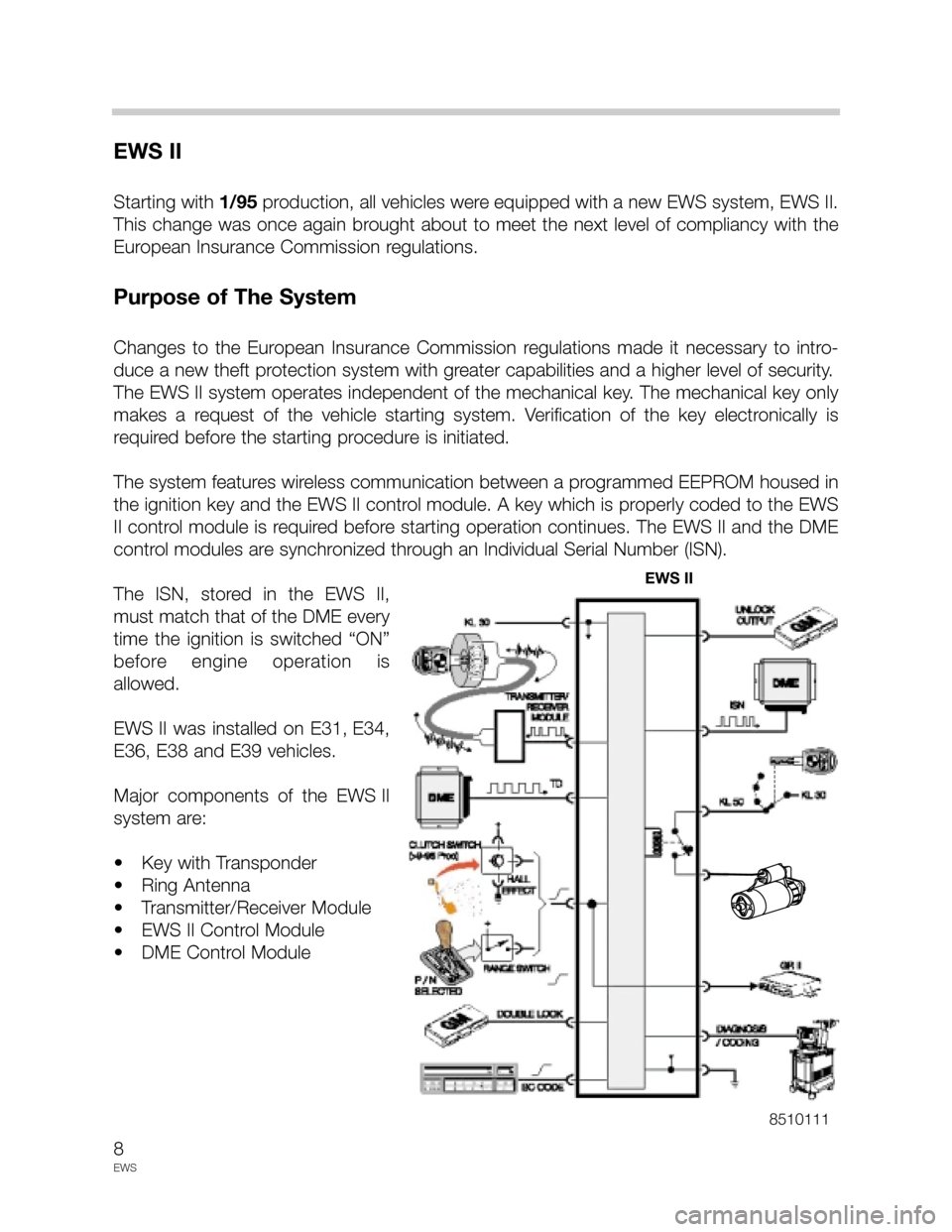
8
EWS
EWS II
Starting with 1/95production, all vehicles were equipped with a new EWS system, EWS II.
This change was once again brought about to meet the next level of compliancy with the
European Insurance Commission regulations.
Purpose of The System
Changes to the European Insurance Commission regulations made it necessary to intro-
duce a new theft protection system with greater capabilities and a higher level of security.
The EWS II system operates independent of the mechanical key. The mechanical key only
makes a request of the vehicle starting system. Verification of the key electronically is
required before the starting procedure is initiated.
The system features wireless communication between a programmed EEPROM housed in
the ignition key and the EWS II control module. A key which is properly coded to the EWS
II control module is required before starting operation continues. The EWS II and the DME
control modules are synchronized through an Individual Serial Number (ISN).
The ISN, stored in the EWS II,
must match that of the DME every
time the ignition is switched “ON”
before engine operation is
allowed.
EWS II was installed on E31, E34,
E36, E38 and E39 vehicles.
Major components of the EWS II
system are:
• Key with Transponder
• Ring Antenna
• Transmitter/Receiver Module
• EWS II Control Module
• DME Control Module
8510111
EWS II
Page 11 of 30
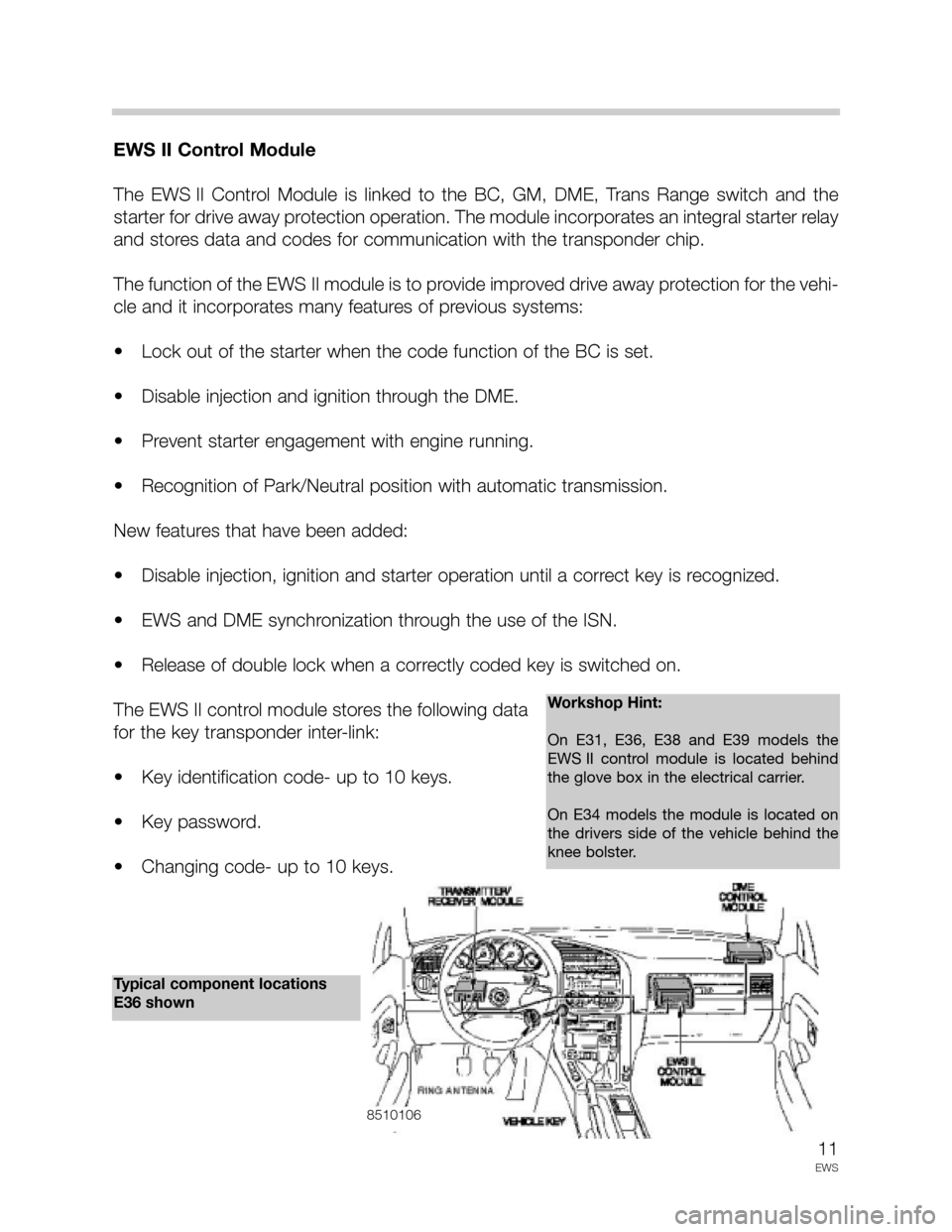
11
EWS
EWS II Control Module
The EWS II Control Module is linked to the BC, GM, DME, Trans Range switch and the
starter for drive away protection operation. The module incorporates an integral starter relay
and stores data and codes for communication with the transponder chip.
The function of the EWS II module is to provide improved drive away protection for the vehi-
cle and it incorporates many features of previous systems:
• Lock out of the starter when the code function of the BC is set.
• Disable injection and ignition through the DME.
• Prevent starter engagement with engine running.
• Recognition of Park/Neutral position with automatic transmission.
New features that have been added:
• Disable injection, ignition and starter operation until a correct key is recognized.
• EWS and DME synchronization through the use of the ISN.
• Release of double lock when a correctly coded key is switched on.
The EWS II control module stores the following data
for the key transponder inter-link:
• Key identification code- up to 10 keys.
• Key password.
• Changing code- up to 10 keys.
Workshop Hint:
On E31, E36, E38 and E39 models the
EWS II control module is located behind
the glove box in the electrical carrier.
On E34 models the module is located on
the drivers side of the vehicle behind the
knee bolster.
8510106
Typical component locations
E36 shown
Page 12 of 30
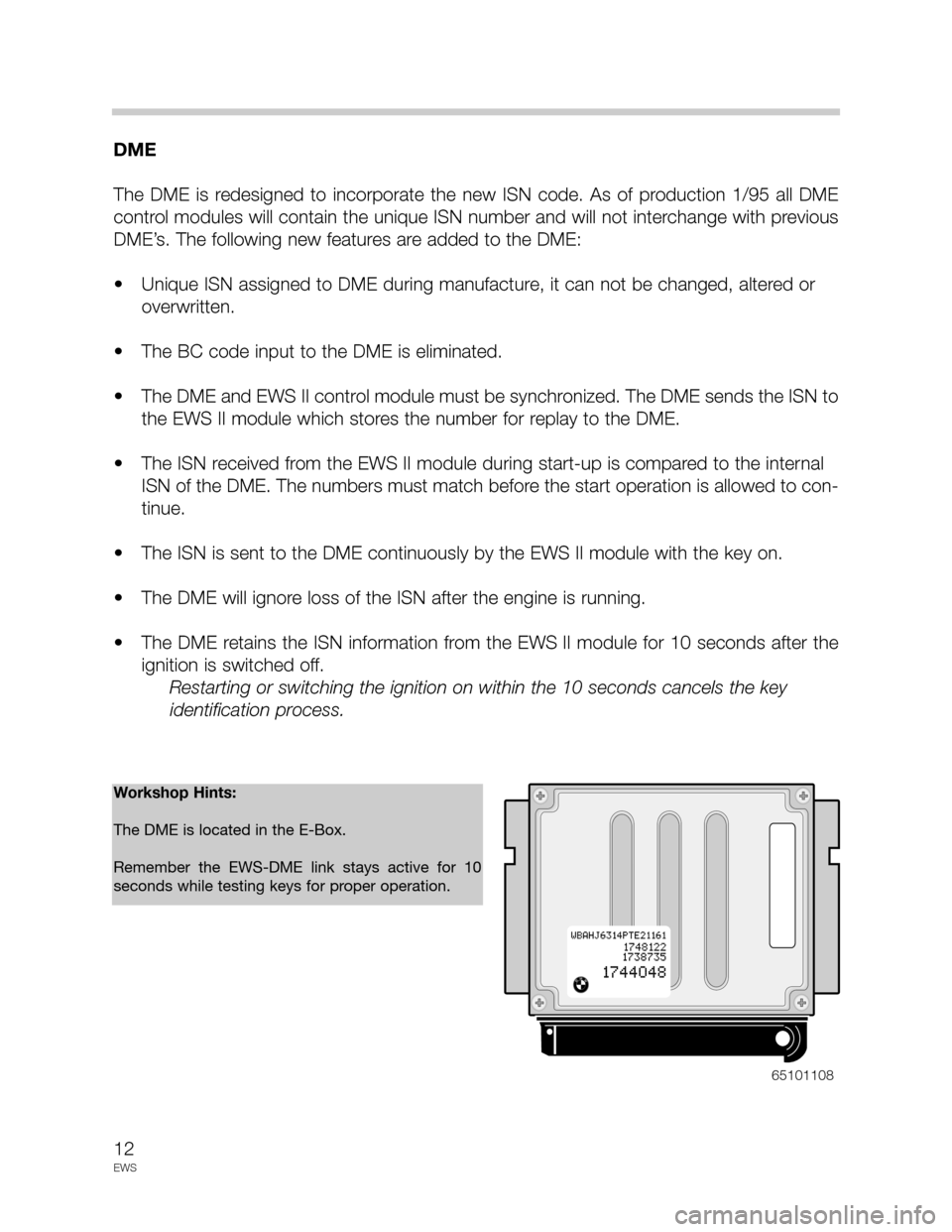
12
EWS
DME
The DME is redesigned to incorporate the new ISN code. As of production 1/95 all DME
control modules will contain the unique ISN number and will not interchange with previous
DME’s. The following new features are added to the DME:
• Unique ISN assigned to DME during manufacture, it can not be changed, altered or
overwritten.
• The BC code input to the DME is eliminated.
• The DME and EWS II control module must be synchronized. The DME sends the ISN to
the EWS II module which stores the number for replay to the DME.
• The ISN received from the EWS II module during start-up is compared to the internal
ISN of the DME. The numbers must match before the start operation is allowed to con-
tinue.
• The ISN is sent to the DME continuously by the EWS II module with the key on.
• The DME will ignore loss of the ISN after the engine is running.
• The DME retains the ISN information from the EWS II module for 10 seconds after the
ignition is switched off.
Restarting or switching the ignition on within the 10 seconds cancels the key
identification process.
Workshop Hints:
The DME is located in the E-Box.
Remember the EWS-DME link stays active for 10
seconds while testing keys for proper operation.
65101108
Page 15 of 30
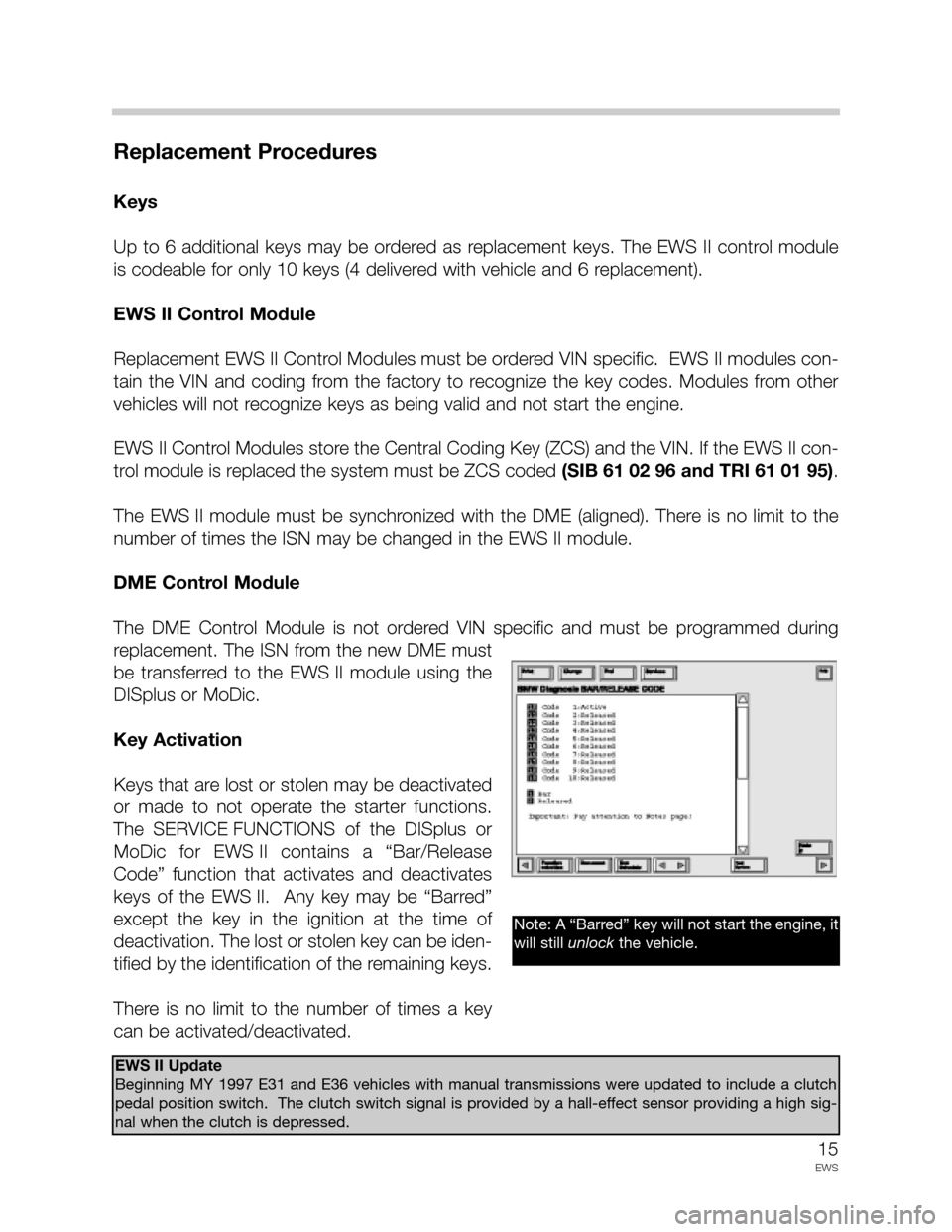
15
EWS
Replacement Procedures
Keys
Up to 6 additional keys may be ordered as replacement keys. The EWS II control module
is codeable for only 10 keys (4 delivered with vehicle and 6 replacement).
EWS II Control Module
Replacement EWS II Control Modules must be ordered VIN specific. EWS II modules con-
tain the VIN and coding from the factory to recognize the key codes. Modules from other
vehicles will not recognize keys as being valid and not start the engine.
EWS II Control Modules store the Central Coding Key (ZCS) and the VIN. If the EWS II con-
trol module is replaced the system must be ZCS coded (SIB 61 02 96 and TRI 61 01 95).
The EWS II module must be synchronized with the DME (aligned). There is no limit to the
number of times the ISN may be changed in the EWS II module.
DME Control Module
The DME Control Module is not ordered VIN specific and must be programmed during
replacement. The ISN from the new DME must
be transferred to the EWS II module using the
DISplus or MoDic.
Key Activation
Keys that are lost or stolen may be deactivated
or made to not operate the starter functions.
The SERVICE FUNCTIONS of the DISplus or
MoDic for EWS II contains a “Bar/Release
Code” function that activates and deactivates
keys of the EWS II. Any key may be “Barred”
except the key in the ignition at the time of
deactivation. The lost or stolen key can be iden-
tified by the identification of the remaining keys.
There is no limit to the number of times a key
can be activated/deactivated.
EWS II Update
Beginning MY 1997 E31 and E36 vehicles with manual transmissions were updated to include a clutch
pedal position switch. The clutch switch signal is provided by a hall-effect sensor providing a high sig-
nal when the clutch is depressed.
Note: A “Barred” key will not start the engine, it
will still unlockthe vehicle.
Page 16 of 30
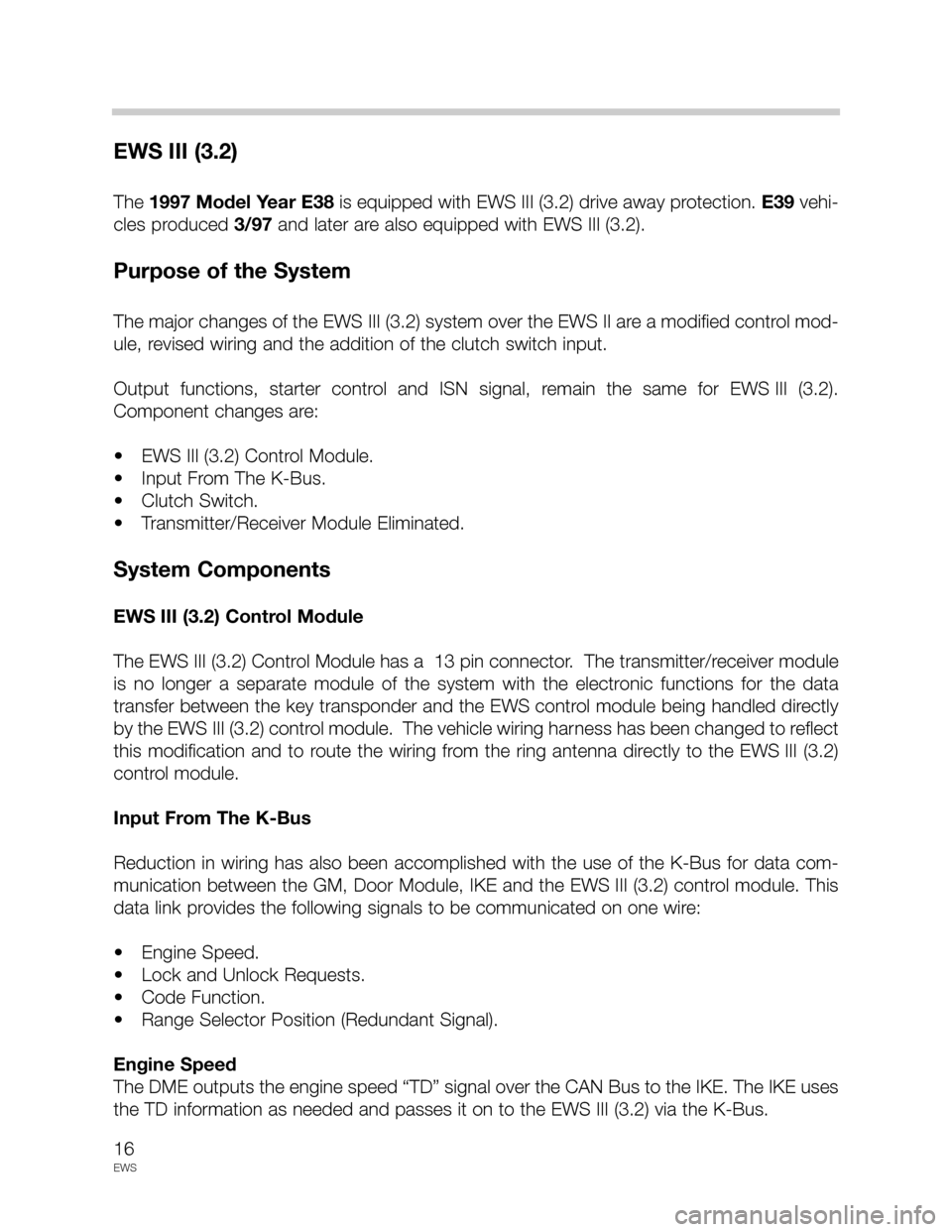
16
EWS
EWS III (3.2)
The 1997 Model Year E38is equipped with EWS III (3.2) drive away protection. E39vehi-
cles produced 3/97and later are also equipped with EWS III (3.2).
Purpose of the System
The major changes of the EWS III (3.2) system over the EWS II are a modified control mod-
ule, revised wiring and the addition of the clutch switch input.
Output functions, starter control and ISN signal, remain the same for EWS III (3.2).
Component changes are:
• EWS III (3.2) Control Module.
• Input From The K-Bus.
• Clutch Switch.
• Transmitter/Receiver Module Eliminated.
System Components
EWS III (3.2) Control Module
The EWS III (3.2) Control Module has a 13 pin connector. The transmitter/receiver module
is no longer a separate module of the system with the electronic functions for the data
transfer between the key transponder and the EWS control module being handled directly
by the EWS III (3.2) control module. The vehicle wiring harness has been changed to reflect
this modification and to route the wiring from the ring antenna directly to the EWS III (3.2)
control module.
Input From The K-Bus
Reduction in wiring has also been accomplished with the use of the K-Bus for data com-
munication between the GM, Door Module, IKE and the EWS III (3.2) control module. This
data link provides the following signals to be communicated on one wire:
• Engine Speed.
• Lock and Unlock Requests.
• Code Function.
• Range Selector Position (Redundant Signal).
Engine Speed
The DME outputs the engine speed “TD” signal over the CAN Bus to the IKE. The IKE uses
the TD information as needed and passes it on to the EWS III (3.2) via the K-Bus.
Page 17 of 30
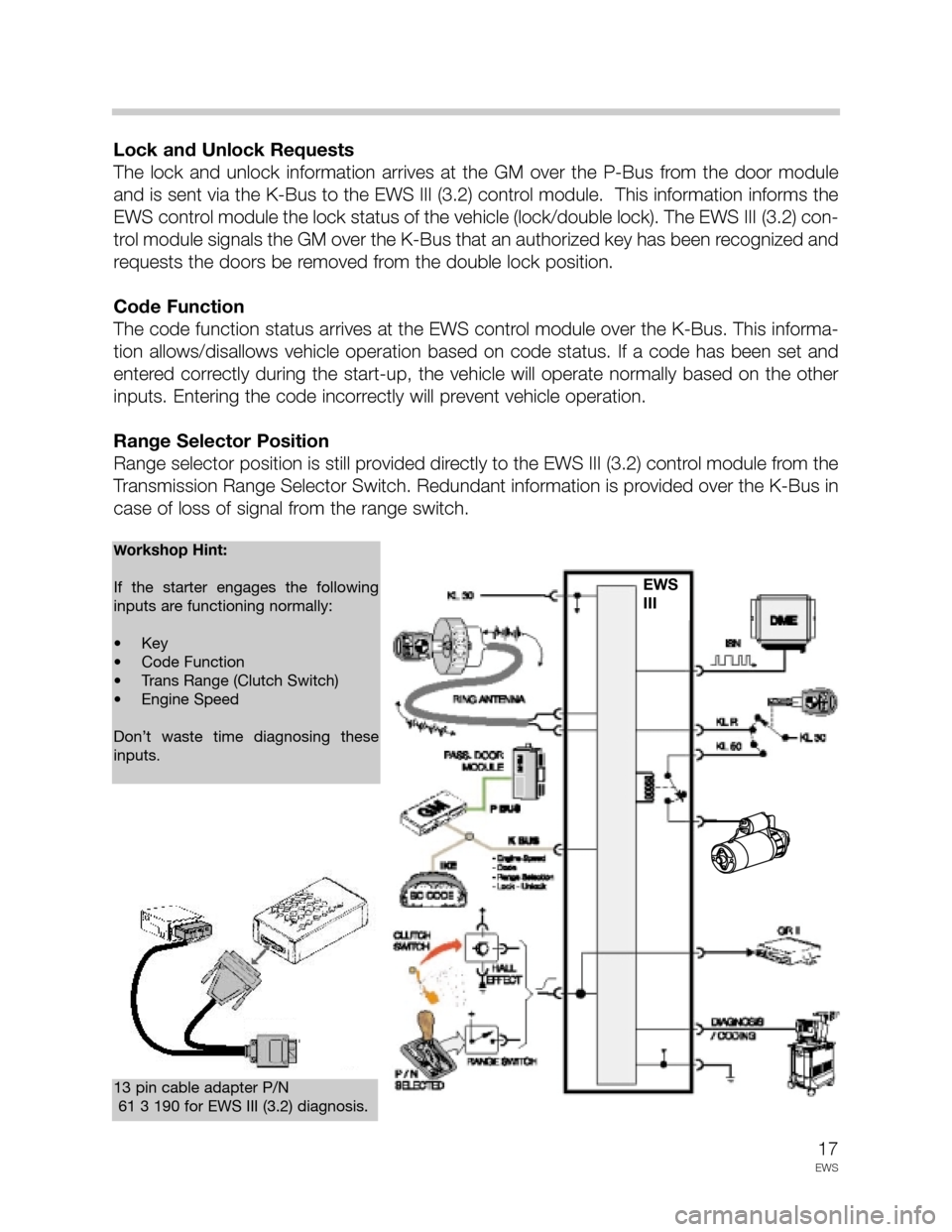
17
EWS
Lock and Unlock Requests
The lock and unlock information arrives at the GM over the P-Bus from the door module
and is sent via the K-Bus to the EWS III (3.2) control module. This information informs the
EWS control module the lock status of the vehicle (lock/double lock). The EWS III (3.2) con-
trol module signals the GM over the K-Bus that an authorized key has been recognized and
requests the doors be removed from the double lock position.
Code Function
The code function status arrives at the EWS control module over the K-Bus. This informa-
tion allows/disallows vehicle operation based on code status. If a code has been set and
entered correctly during the start-up, the vehicle will operate normally based on the other
inputs. Entering the code incorrectly will prevent vehicle operation.
Range Selector Position
Range selector position is still provided directly to the EWS III (3.2) control module from the
Transmission Range Selector Switch. Redundant information is provided over the K-Bus in
case of loss of signal from the range switch.
13 pin cable adapter P/N
61 3 190 for EWS III (3.2) diagnosis.
Workshop Hint:
If the starter engages the following
inputs are functioning normally:
• Key
• Code Function
• Trans Range (Clutch Switch)
• Engine Speed
Don’t waste time diagnosing these
inputs
.
EWS
III